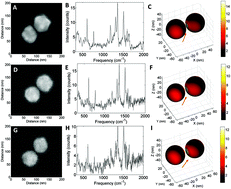Correlative SEM SERS for quantitative analysis of dimer nanoparticles†
Abstract
A Raman microscope integrated with a scanning electron microscope was used to investigate plasmonic structures by correlative SEM-SERS analysis. The integrated Raman-SEM microscope combines high-resolution electron microscopy information with SERS signal enhancement from selected nanostructures with adsorbed Raman reporter molecules. Correlative analysis is performed for dimers of two gold nanospheres. Dimers were selected on the basis of SEM images from multi aggregate samples. The effect of the orientation of the dimer with respect to the polarization state of the laser light and the effect of the particle gap size on the Raman signal intensity is observed. Additionally, calculations are performed to simulate the electric near field enhancement. These simulations are based on the morphologies observed by electron microscopy. In this way the experiments are compared with the enhancement factor calculated with near field simulations and are subsequently used to quantify the SERS enhancement factor. Large differences between experimentally observed and calculated enhancement factors are regularly detected, a phenomenon caused by nanoscale differences between the real and ‘simplified’ simulated structures. Quantitative SERS experiments reveal the structure induced enhancement factor, ranging from ∼200 to ∼20 000, averaged over the full nanostructure surface. The results demonstrate correlative Raman-SEM microscopy for the quantitative analysis of plasmonic particles and structures, thus enabling a new analytical method in the field of SERS and plasmonics.


 Please wait while we load your content...
Please wait while we load your content...